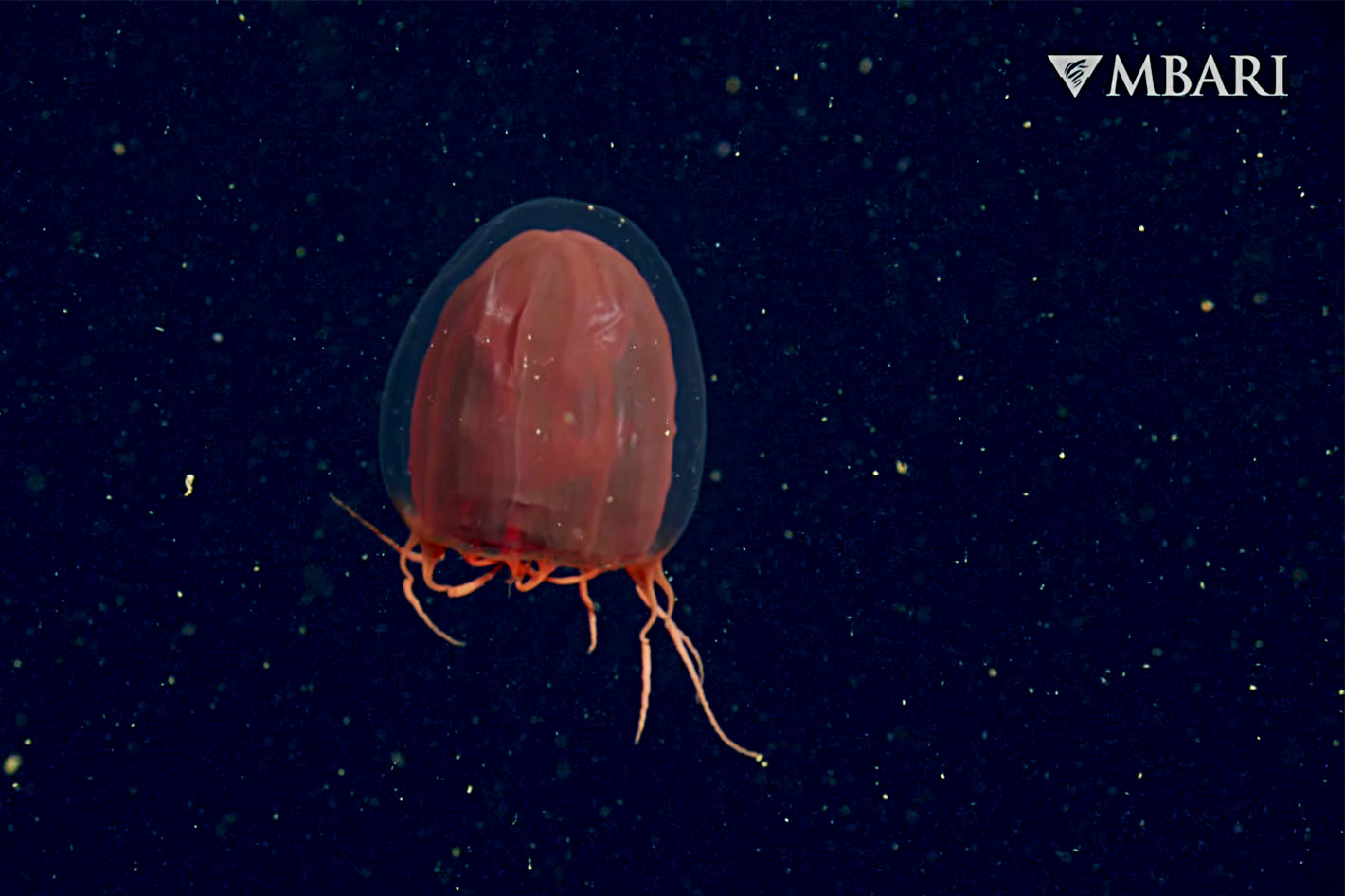
Some of the 4K video captured by the MxD SeaCam, the first-of-its-kind 4K underwater imaging system, will be featured in an upcoming exhibition from the institute’s education and conservation partner, the Monterey Bay Aquarium. Into the Deep: Exploring Our Undiscovered Ocean will transport visitors into the largest living space on Earth, telling stories of the creatures that live there and the people and discoveries that are illuminating the last unexplored reaches of our planet.
Opening April 9, 2022, the new exhibition will bring visitors face-to-face with deep-sea animals and showcase Monterey Bay Aquarium Research Institute (MBARI) video, including the new and never-before-seen 4K footage. Video is a precious—and unique—resource at MBARI. High-definition, or HD, cameras on MBARI’s remotely operated vehicles (ROVs) have recorded thousands of hours of video helping the institute’s research team piece together the mysteries of Earth’s largest, but least explored, living space.
In fact, in 34 years of deep-sea research, MBARI’s ROVs have logged more than 5,800 dives. Research groups across the institute mine an associated archive of more than 27,600 hours of video to learn about the deep sea. Video is also important for education and outreach. Images and video recorded by ROVs Ventana, Tiburon (now retired), and Doc Ricketts are shared across MBARI’s social media platforms and have been showcased in publications, productions, and exhibitions around the world.
MBARI was founded in 1987 by David Packard, who co-founded Hewlett-Packard Company and was a former Deputy Secretary of Defense. MBARI’s mission is to advance marine science and technology to understand the changing ocean and disseminate this knowledge to the community at large. Partnering with a well-established commercial vendor helps MBARI transfer technology innovations to the global market. In October 2019, MBARI enlisted DeepSea Power & Light to develop the new underwater 4K camera. DeepSea Power & Light has extensive experience with glass camera domes at pressure and understood the challenges for developing a camera for MBARI’s deep-diving ROVs.
The last great advance in MBARI’s video imaging capabilities was more than 20 years ago, when the institute transitioned to recording in an HD television format—1080i resolution, or 1920 by 1080 pixels. The higher quality enabled researchers to better document deep-sea animals and environments. With video imaging worldwide now transitioning to 4K resolutions, MBARI saw an exciting opportunity to develop a camera system that takes full advantage of the higher resolution, color rendition, dynamic range, and frame rates that this format offers. The team selected the broadcast-quality 4K UHD format with a pixel resolution of 3840 by 2160—a resolution exactly four times that of HD.
“Seeing the rapid adoption of 4K imaging and recognizing the scientific value that increased resolution brings to our research team, MBARI began evaluating opportunities to upgrade the HD camera systems on our ROVs to 4K in 2018,” explained MBARI Electrical Engineer Mark Chaffey. “The new MxD SeaCam that we developed with DeepSea Power & Light captures life in the deep sea in astonishing detail.”
Over the last two years, the camera’s ambitious design took shape. The result of this collaboration is the MxD SeaCam—a first-of-its-kind 4K underwater imaging system. After a test run on the ROV Ventana, the MxD SeaCam is now installed on MBARI’s ROV Doc Ricketts (pictured above), a vehicle capable of diving 4,000 meters (13,100 feet) deep.
Here is the information about the MxD SeaCam provided by DeepSea Power & Light:
At the heart of the MxD is the subsea imaging unit, based on a Sony HDC-50 compact broadcast camera with the performance and advanced features of full-sized studio systems. The 4K-UHD resolution 2/3” class 3-CMOS global shutter optical block provides unparalleled sensitivity, sharpness, support for HDR (hyper gamma) and the full BT.2020 color space along with the full range of controls expected from a no-compromise, future-proof studio grade platform.
The imaging potential is matched with a best-in-class Canon CJ15ex4.3 wide-angle zoom lens with 15x magnification, providing a 96° horizontal field of view at full wide and just 8.4° at full telephoto. This lens is coupled with a custom 4-element dome port corrector cell for near zero distortion viewing and diffraction limited performance from 0.3meters to infinity.
The purpose-built Titanium housing and borosilicate dome of the MxD SeaCam provide reliable operation to 4000m with options for up to 7000m depths using a patent pending design, proven across thousands of actual pressure cycles.
Video uplinks and camera controls are integrated into an embedded telemetry system connected through a single fiber optic interface to a top-side hub that provides industry standard 12G-SDI video and familiar remote camera and lens controls.
The first few expeditions utilizing the MxD SeaCam have already proven rewarding, providing high-quality video to fuel MBARI’s research. The MxD SeaCam camera, says the team at MBAR, provides an exciting new level of visibility into the deep sea. The footage captured by this camera promises to advance not only research, but also education. Images are the most powerful way to communicate the beauty and importance of the deep sea and share the scientific knowledge and discoveries made there with the public.
Follow the link to Monterey Bay Aquarium Research Institute (MBARI) website to read the full story.
